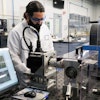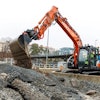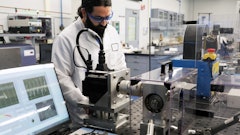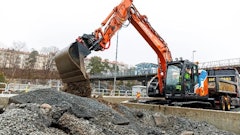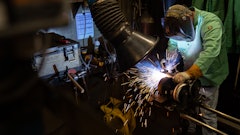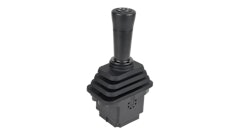The 30,000-lb. Volvo DD138HF double-drum asphalt compactor smoothly rolls towards me with the operator focused on his task. Normally I would brace for the blast of engine noise and the roar of the cooling fan, but this machine is different. It is outfitted with an electronic controller that has adjusted the engine speed down to near its torque peak.
To compensate for the lower engine rpm, it has adjusted the hydrostatic propel pump and the hydrostatic vibe-circuit pumps to a higher flow to meet the operator’s commanded travel speed and vibe frequency. Since the engine coolant and hydraulic oil temperatures are under predetermined set points, the controller had modulated the cooling fan to a reduced speed.
This machine provides the operator with a better working environment. It provides the owner with significant fuel savings, and it has a much smaller carbon footprint.
This large asphalt compactor is a demonstration machine that uses a Sauer-Danfoss PLUS+1 electronic controller to select the optimum engine speed for the combination of commanded vehicle speed, vibe frequency and the temperature of the coolant and hydraulic oil. This system was chosen because it is powerful, simple to use and the program can be quickly modified during prototyping and testing. This modular and expandable controller can utilize CAN messages from sensors already on the engine and the rest of the vehicle.
The hydrostatically propelled machine uses a Sauer-Danfoss H1 Series 78cc electronic displacement control pump. The controller continuously monitors the vehicle speed command and adjusts both the engine speed and pump displacement to maintain the commanded travel speed.
Since vibe frequency (vibe motor speed) must be closely controlled, this double drum roller has been fitted with Sauer-Danfoss H1T tandem 53cc electronic displacement control hydrostatic pumps, each which feed a Sauer-Danfoss 35cc axial-piston motor. These motors directly drive the drum eccentrics and send motor-speed signals back to the electronic control system.
In order to enable full cooling capacity when needed, and to minimize fan horsepower at all other times, the cooling fan has been decoupled from the engine. The fan is powered by a Sauer-Danfoss electronically controlled modulating fan motor.
The PLUS+1 controller monitors coolant temperature, hydraulic oil temperature and engine speed. When temperature set points are exceeded, the fan speed is increased to provide additional cooling. Since the cooling systems on most machines are sized to handle peak heat loads at high ambient temperatures, in typical operating conditions the actual fan speed is almost always less than its maximum speed. This provides significant reductions in noise and fuel usage.
Fuel savings
How much fuel can a system like this save? Under typical conditions and with the circuits described above, a 30% reduction in fuel use was measured, from 24.8 liter/hour with the standard machine running at 2,250 rpm, down to 17.2 liter/hour with the engine speed running near 1,730 rpm. The control system was designed so that it could be turned off and on to make this comparison possible.
The fuel savings reflect reduced frictional losses in the engine, reduced “windage” losses in the engine and hydraulic pumps, and lower charge pressure and flow losses. The fuel savings also reflect the significantly lower power requirement of the cooling fan.
Typically, hydraulic components are sized only as large as needed to meet machine specifications. With this approach, the size of the hydraulic components might reflect the displacement and flows needed for keeping the engine at optimum speed instead of maximum speed. The predicted life of the axial piston pumps does not go down. Since the system pressure has not changed, the calculated life of the pump rotating kit has not been reduced. In fact, due to the lower pump speed, the expected life is a little higher.
How is the operator affected? Since the PLUS+1 controller is doing the work of monitoring and controlling engine speed, vibe speed and fan speed, the operator can put more care into the quality of the asphalt mat. The productivity of the machine is built in.
Jim Eisenmenger is a Sauer-Danfoss systems and applications engineer in Ames, IA.

